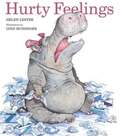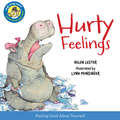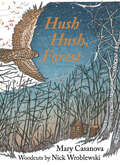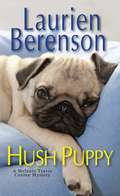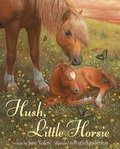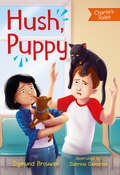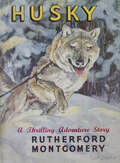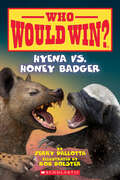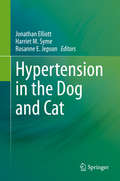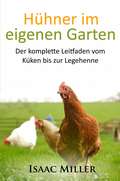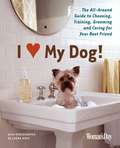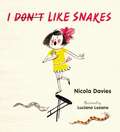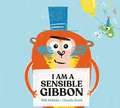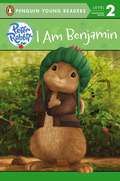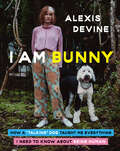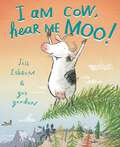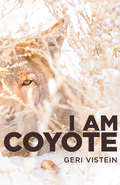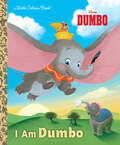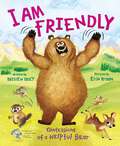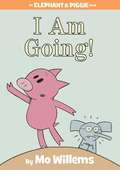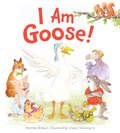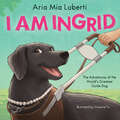- Table View
- List View
Hurty Feelings
by Helen LesterFragility was a solid piece of work. But despite her sturdy exterior, Fragility was fragile. Anything and everything hurt her feelings. In the most benign compliment, Fragility heard an insult. No one could even say she looked nice without evoking images of big, squishy cupcakes--since they are also nice--and causing Fragility to flop on the ground and weep. Fragility's friends stop speaking to her for fear of another fit, but Rudy, a very rude bully, has other ideas. In the face of real insults, will Fragility finally learn to take a compliment?
Hurty Feelings (Read-aloud)
by Helen Lester Lynn MunsingerFragility was a solid piece of work. But despite her sturdy exterior, Fragility was fragile. Anything and everything hurt her feelings. In the most benign compliment, Fragility heard an insult. No one could even say she looked nice without evoking images of big, squishy cupcakes--since they are also nice--and causing Fragility to flop on the ground and weep. Fragility's friends stop speaking to her for fear of another fit, but Rudy, a very rude bully, has other ideas. In the face of real insults, will Fragility finally learn to take a compliment? This ebook includes audio narration.
Hush Hush, Forest
by Mary CasanovaLyrical words and elegant woodcuts capture the quiet beauty of the forest as day fades to night and autumn gives way to the North Woods winter While we are tucked in, snug in warm blankets as we listen to bedtime stories, the woods around us whisper another tale. As the golden leaves waft through the lengthening shadows, the loon sings one last lullaby, the whirring hummingbird takes one last sip, the industrious beaver saws one last branch for her lodge. Here, in enchanting words and woodcuts, is the magic of night falling and winter approaching in the North Woods. Hush Hush, Forest peers through twilight&’s window at the raccoon preening, the doe and fawn bedding down, the last bat of the season flitting away. The owl surveys, the rabbit scurries, the bear hunkers, readying her den.Marking the rhythm between the falling leaf and the falling snowflake, picturing the rituals of creatures big and small as they prepare for the long winter&’s sleep, this charming book captures a time of surpassing wonder for readers of all ages—and bids everyone in the hushed forest a peaceful good night.
Hush Puppy (A Melanie Travis Canine Mystery #6)
by Laurien BerensonThere&’s a corpse on campus in this mystery from an Agatha Award finalist who&’s &“a rare breed of writer&” (The Plain Dealer). Melanie Travis loves her teaching job at Connecticut&’s elite Howard Academy, where plans are underway for a Spring Pageant to honor the school&’s fiftieth anniversary. Immersed in the preparations, Melanie is hurrying to retrieve a painting of one of the illustrious co-founders when she comes upon a disturbing scene: Eugene Krebbs, the Academy&’s elderly caretaker, is arguing loudly with a girl half his size. Before Melanie can learn more than the girl&’s first name—Jane—she disappears. It&’s clear that Jane isn&’t a student at Howard Academy, so what is she doing there? Melanie doesn&’t have a chance to answer that question before more problems arise. Two days later, Krebbs is discovered stabbed to death right on the school grounds. Now Melanie is embroiled in a full-fledged homicide investigation as she tries to find out who&’s added murder to the school's curriculum. &“Fans of Miranda James&’ Cat in the Stacks series may also enjoy Berenson.&”—Booklist &“If you like dogs, you&’ll love Laurien Berenson&’s Melanie Travis mysteries!&”—Joanne Fluke, New York Times-bestselling author of the Hannah Swensen series
Hush, Little Horsie
by Jane Yolen Ruth SandersonHush, little horsie,Asleep on the moor.Your mama is close--That's what mamas are for.Mama horses around the world promise to watch over their little ones as the foals frolic and play and eventually fall asleep in this soothing bedtime story. Young horse lovers will drift off with Ruth Sanderson's stunning horses in their minds and the promise of their own parents' enduring love in their hearts.Award-winning author Jane Yolen has written the New York Times bestselling How Do Dinosaurs . . . series and Owl Moon, winner of the Caldecott Medal. In Hush, Little Horsie, she has dreamed up a lovely rhyming read-aloud for a mother and child to snuggle up with.This gorgeous picture book is perfect for horse lovers big and small--and for mothers in need of a good bedtime story.From the Hardcover edition.
Hush, Puppy: Charlie's Rules #3 (Orca Echoes)
by Sigmund BrouwerEleven-year-old Charlie Dembinski lives by the rules he writes down in his notebook. He knows that animals behave in predictable ways and it's easy for him to understand them. What Charlie doesn’t understand is why people aren’t the same way. Faced with a swarm of bees attached to a car, a cat with an unusual lump, a large dog who eats jewelry, a little dog who’s lost his confidence, and a best friend who’s upset for reasons he doesn’t understand, Charlie is put to the test. Can his rules help solve these problems? The third book in the Charlie's Rules series from bestselling author Sigmund Brouwer, Hush, Puppy is sure to delight young animal lovers. The straightforward plot, black-and-white illustrations and unique animal stories make this the perfect chapter book for early readers. The epub edition of this title is fully accessible.
Husky with a Heart (Animal Ark #47)
by Ben M. BaglioMandy and James meet Hannah, who owns a dogsled team and is about to get married. The team has a race, but the lead dog is injured, and they can't race without a lead. Meanwhile, at Animal Ark, there's a ferret in trouble. Will Hannah get married? Will the ferret be okay? What about the race, will they get a new lead dog?
Husky: Co-Pilot of the Pilgrim
by Rutherford MontgomeryKent McIntosh has saved enough money to buy a small plane, the Pilgrim. Along with his wolf-dog and co-pilot, Husky, he becomes a brush-hopper, delivering supplies to mining camps. All goes well until the plane goes down in the wilderness and Husky must save both Kent's life and the rest of the dog team.
Hyena vs. Honey Badger (Who Would Win? #20)
by Jerry PallottaWhat if a hyena picked a fight with a honey badger? Who do you think would win?This nonfiction reader compares and contrasts two ferocious animals.Readers will learn about each animal's anatomy, behavior, and more. Then compare and contrast the battling pair before finally discovering the winner! This nonfiction series is full of facts, photos, and realistic illustrations, and it includes a range of mammals, sea creatures, insects, and dinosaurs to satisfy all kinds of animal fans.
Hypertension in the Dog and Cat
by Jonathan Elliott Harriet M. Syme Rosanne E. JepsonThis book provides an in-depth review on various aspects of canine and feline hypertension. Physiology, pathophysiology, epidemiology and pathological consequences of high blood pressure in cats and dogs are discussed. A comparative approach is taken, the underpinning research is critically evaluated and knowledge gaps identified. In addition, the reader is presented with evidence-based treatment strategies. The book targets researchers, graduate students and clinical specialists in small animal internal medicine as well as veterinary clinicians with interest in nephrology, cardiology, neurology and ophthalmology.
Hypsodonty in Mammals
by Richard H. MaddenThe evolution of high-crowned teeth, hypsodonty, is a defining characteristic of many terrestrial herbivores. To date, the most prominent focus in the study of the teeth of grazing herbivores has been co-evolution with grasses and grasslands. This book develops the idea further and looks at the myriad ways that soil can enter the diet. Madden then expands this analysis to examine the earth surface processes that mobilize sediment in the environment. The text delivers a global perspective on tooth wear and soil erosion, with examples from the islands of New Zealand to the South American Andes, highlighting how similar geological processes worldwide result in convergent evolution. The final chapter includes a review of elodonty in the fossil record and its environmental consequences. Offering new insights into geomorphology and adaptive and evolutionary morphology, this text will be of value to any researcher interested in the evolution of tooth size and shape.
Hühner im eigenen Garten: Der komplette Leitfaden vom Küken bis zur Legehenne
by Isaac MillerHühner im eigenen Garten zu halten, ist viel einfacher als so manch anderes Haustier. Ein paar Minuten Kontrolle am Tag reichen, um täglich frische Eier genießen zu können. In disem Buch werden wir die nötigen Schritte durchgehen, von Kauf und Pflege der jungen Küken bis zur Umsiedlung in den Stall im Garten, mit allem, was dazwischen geschieht. Nehmen Sie sich etwas zu trinken und einen Snack, finden Sie einen schönen Platz zum schmökern und gemeinsam entdecken wir, welche Freude Hühner im Garten bereiten können. In diesem Buch werden wir Sie begleiten bei: Platzsuche und Stallgröße Auswahl einer Hühnerrasse Aufzucht der Küken Umsiedeln in den Stall Stallund Auslauf sauber halten Hühner richtig füttern Genießen Sie das Leben mit diesem Buch und Ihren gefiederten Freunden!
I (Heart) My Dog!: The Guide to Choosing, Training, Grooming and Caring for Your Best Friend
by The Editors of Woman's DayMore than half of America 's pet owners consider their pet as much a part of their family as any other member and it's a fact that caring for animals improves our emotional and physical health. This puppy and dog reference manual from the experts at Woman's Day contains information on lifelong care for your dogs, including: Favorite, popular and unusual names for dogs, as well as how to choose the right breed for your lifestyle; The Ins and Outs of housebreaking, grooming and keeping your dogs healthy and happy; Puppy health care, including information about insurance and choosing the right vet; Essential tips for traveling with your dog; Green pet care, from making your own dog food to natural treatments for ailments. I Heart My Dog is your all-in-one reference for caring for your trusty companion. If you're just thinking about getting a dog or want to learn more about protecting the one you have, this reliable source will teach you everything you need to know to make doggy care affordable and easy!
I (don't) Like Snakes
by Nicola Davies Luciano Lozano<P>This little girl has a problem. Her family doesn't have dogs, or cats, or birds--they have snakes! And she really, really, really really doesn't like snakes. <P>Her family can't understand her dislike, but they can help her understand why snakes do the things they do and look the way they look. And maybe once she knows more, she will start to like snakes a little . . . or even a lot. <P> Packed with snake trivia, this clever story includes realistic illustrations and simple explanations of snake behavior sure to make even slither-phobic readers shed their misconceptions about these fascinating reptiles. Back matter includes a note about snakes, a bibliography, and an index.
I Am A Sensible Gibbon
by Will MabbittA very sensible story with ABSOLUTELY NO SILLINESS! From the author of I Can Only Draw Worms!Gibbon would like to make it very clear that this is a sensible book for sensible people. Anything that looks like it might be FUN or SILLY is absolutely forbidden.A hilarious, rhyming animal party, with colourful illustrations by Claudia Boldt.
I Am Benjamin (Peter Rabbit Animation)
by Penguin Young ReadersMeet Benjamin Bouncer!Best friend to Peter Rabbit and Lily Bobtail, Benjamin is the comic relief in the show. He's always hungry, the most timid of the trio, and yet the most loyal friend there is. Benjamin, Peter, and Lily are ready for another adventure. Let's hop to it!
I Am Bunny: How a Talking Dog Taught Me Everything I Need to Know About Being Human
by Alexis DevineSocial media stars of @WhatAboutBunny, Alexis Devine and Bunny the "talking" dog, deliver a memoir loaded with wit and passion for animals, as well as the vulnerability and authenticity of a woman who learned to take care of herself by learning to talk to her dogWhen Bunny, a fluffy, black-and-white sheepadoodle, was eight weeks old, her guardian Alexis presented her with an odd gift: a button programed to say “outside” when pressed. Within a few weeks, Bunny was using it all the time and Alexis, encouraged by Bunny’s progress, continued to introduce more buttons and more words . . .Three years later, Bunny can now communicate using over one hundred buttons, stringing together important, relatable, philosophical phrases such as “Love you Mom,” “Dad went poop,” and “Ugh why?” In I Am Bunny, a memoir in essays and beautiful, full-color photographs, Alexis chronicles not only how Bunny learned to “talk,” but also the profound impact their journey has had on her life. Caring for Bunny has revealed to Alexis a path to self-acceptance, if not complete self-love, and as their relationship developed and their ability to communicate deepened, Alexis was able to reflect on and reframe her past traumas in a newly vulnerable and healing way. Helping Bunny through her fear and reactivity allowed Alexis to examine these qualities in herself, and as she created a safe space for Bunny, she too found space for her own healing.Through charming anecdotes about day-to-day life with Bunny, explorations into prior animal language studies, and plenty of irreverent humor, daring, and heart, Alexis tells the story of how she and Bunny have become so inspiringly close, and explores the ancient and unique bond between dog and guardian that so many of us know leads to a deeper, more meaningful life.
I Am Cow, Hear Me Moo!
by Jill EsbaumA high-stakes adventure and hilarious ode to self-esteem for fans of Oliver Jeffers, Click, Clack, Moo: Cows That Type, and Louise, The Adventures of a Chicken.Nadine can talk a blue streak, and one day she tells a real whopper: she isn't afraid of anything--no siree! Then her friends call her bluff, and Nadine must enter. . .The Deep. Dark. Woods. Only the woods aren't so scary after all, until the sun sets, that is, and Nadine can't find her friends. What is this boastful bovine to do? Run around in blind terror? Plummet off a cliff? Crash into a stream? Check, check, and check. But is all lost? Doubtful. After all, she is cow, hear her MOOOOOOOOO!
I Am Coyote
by Geri VisteinCoyote is three years old when she leaves her family to seek a home of her own and a mate to share it with. Journeying by night through a Canadian winter, she doesn't know that her search will become a 500-mile odyssey. Nor can she know while enduring extreme cold, hunger, and harrowing brushes with death that she and her descendants are destined to play a vital role in the forests of the eastern United States, replacing wolves (exterminated a century ago) as the keystone predator the landscape desperately needed. Combining rigorous science with imaginative storytelling, I Am Coyote reveals the complex outer and inner lives of coyotes. We are not the only sentient beings on this planet; we are not unique in experiencing love, fear, grief, joy, and acceptance. This magical story will change the way you think about the animals with whom we share the world.
I Am Coyote
by Geri VisteinCoyote is three years old when she leaves her family in Algonquin Provincial Park in Ontario and embarks on a 500-mile odyssey eastward in search of a territory of her own and a mate to share it with. Journeying by night through the dead of winter, she endures extreme cold, hunger, and a harrowing crossing of the St. Lawrence River in Montreal before her cries of loneliness are finally answered in the wilds of Maine. The mate she finds must gnaw off a paw to escape a trap. The first coyotes in the northern U.S., they raise pups (losing several), experience summer plenty, winter hardship, playfulness, and unmistakable love and grief. Blending science and imagination with magical results, this story tells how coyotes may have populated a land desperately in need of a keystone predator, and no one who reads it will doubt the value of their ecological role. Told through the eyes of a coyote, this is a riveting story with mythic dimensions. A work of creative nonfiction that adheres to the highest standards of wildlife biology. With deep insights into wild canine behavior, penetrates the veil of "otherness" that separates us from the animals with whom we share the planet. An appendix explores the history and current status of coyotes in North America. Native Americans considered them tricksters, messengers, and companions. Given the disappearance of wolves, they are even more critical to ecosystem health today. The author explains how, without coyotes, prey species are weakened by disease and parasites. Geri Vistein speaks extensively about coyote-human interactions to a variety of audiences. She is a nationally recognized expert on the topic and maintains the website CoyoteLivesInMaine.com. A QR code in the book takes readers to a hauntingly beautiful recording of coyote song.
I Am Dumbo (Little Golden Book)
by Apple JordanThis new Little Golden Book is all about the flying elephant from Disney's Dumbo!This new Little Golden Book celebrates everything that is special about Dumbo, the lovable big-eared elephant from the beloved Disney movie Dumbo. Mrs. Jumbo, Timothy the mouse, and other movie pals are featured in gorgeous retro-style illustrations. This book is a must-have for children ages 2 to 5, as well as Dumbo fans--and collectors--of all ages!The tale of a beloved big-eared elephant who overcomes his fears and teaches that our differences are what make us great, Disney Dumbo is an animated classic for all ages. This Little Golden Book is part of the charming "I Am . . ." series, which provides a unique introduction to favorite Disney characters.
I Am Friendly: Confessions of a Helpful Bear
by Kristen TracyA hilarious picture book that follows the adventures of a well-meaning grizzly bear trying to help her forest friends.Don’t look at this bear and think she is ferocious. Quite the opposite of grizzly. She is friendly!Need directions? She’s your bear. What about an afternoon snack? Look no further. Being this thoughtful has always come naturally to her, and she just knows it’s appreciated by all her forest friends. Keep an eye out! There’s always someone in need of a helping hand—or paw.From the silly to the sincere, I Am Friendly by children's author Kristen Tracy and rising star illustrator Erin Kraan will resonate with every big-hearted reader.
I Am Going!
by Mo WillemsGerald is careful. Piggie is not. Piggie cannot help smiling. Gerald can Gerald worries so that Piggie does not have to. Gerald and Piggie are best friends. In I Am Going! Piggie ruins a perfectly good day by telling Gerald he is going. But if Piggie goes, who will Gerald play ping-pong and wear silly hats with? Mo Willems, a master at comic pacing, delivers another perfectly delightful Elephant & Piggie schtick that will have kids laughing as they learn to read.
I Am Goose!
by Dorothia RohnerA simple, friendly game of Duck, Duck, Goose goes off the rails in giggle-inducing confusion when a silly goose tries to make it all about him. &“Are you kidding me? I am Goose!&” A literal-minded goose derails a favorite childhood game—Duck, Duck, Goose—by objecting when Pig, Fox, Dodo, and other players are tapped as &“Goose.&” Distraction, squabbling, and asking for snacks threaten to end the game completely. Bossy Rabbit restores calm, but Goose doesn&’t understand what the problem is until he gets a taste of his own medicine as several ducks arrive and join in, each insisting, &“I am Duck!&” Engaging animal characters cavort through this spirited, laugh-aloud romp.
I Am Ingrid: The Adventures of the World’s Greatest Guide Dog
by Aria Mia LobertiThis funny, adorable picture book is based on the life of Ingrid, the real guide dog to actress, author, and UNICEF Ambassador Aria Mia Loberti! Ingrid knows she is fabulous. She flies around the world with her person, Aria. Working as a team, they navigate everything from college classes and ancient ruins to movie sets and red carpets. And Ingrid never goes anywhere without her string of pearls. But before Ingrid was the best guide dog there ever was, she was just a small, black puppy with very big paws.Growing up at Guide Dogs for the Blind, Ingrid saw lots of grown-up dogs wearing special harnesses. They were guide dogs, and they got to help people and go on adventures. Ingrid dreamed of being just like them. But becoming a guide dog isn’t easy. It takes a lot of training and hard work. When they are wearing their harnesses, guide dogs must be focused and calm. That means no sniffing strangers, barking, or picking up food from the ground -- no matter how good it smells! But Ingrid was determined to complete her training and become the best guide dog in the world.This funny and heartwarming illustrated picture book will teach kids what guide dogs do and how they work together with their humans to become an unstoppable team. Plus, the back of the book includes nonfiction information about guide dogs, the spectrum of vision, Aria’s life and career, and photos of the real Ingrid -- including her wearing her trademark pearls!
